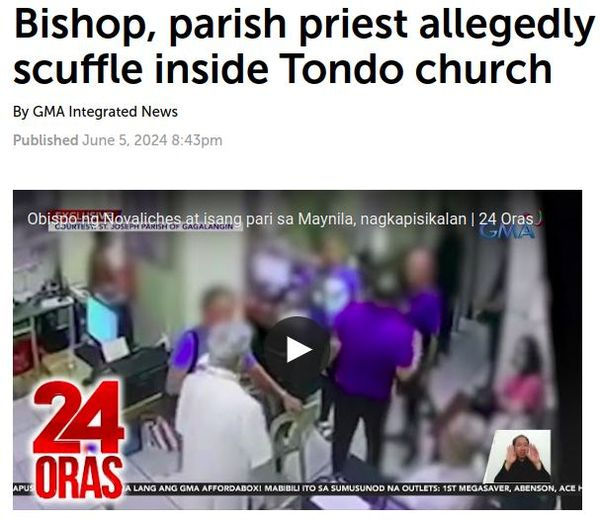Controversy in the Church: Bishop Chokes Priest
- josnardionzon5
- Jun 10, 2024
- 4 min read

In the news: Pari sinakal ng Obispo.
The video went viral after capturing an altercation where an elderly bishop physically restrained a priest, causing him to tumble to the ground. What provoked the bishop to choke him? It’s the priest's words against the bishop's.
The root cause of the scuffle, it was revealed, stemmed from the bishop's attempt to enforce the order for the priest to vacate the parish. The priest met this with defiance and demanded due process, but the bishop said it was already decided and there was no room for discussion, only to follow the instruction.
I am not siding with the priest. He may have a history of conflict with his bishop, fellow priests, and laypeople to whom he was previously or currently assigned. It is said that he defied the order of his archbishop for two years now and after the scuffle, the archdiocese suspended him as a priest and cannot exercise his priestly duties and functions. This is an indefinite sanction and can lead to his defrocking. This is a heavy penalty akin to the death penalty of the priest.
The elderly bishop is supposed to be retired, but it appears he is still active. Otherwise, he has no business in the parish. It is said that the retired bishop was tasked by the archbishop to implement the order to vacate the parish, and based on the conversation, the order is not subject to discussion. It's an ultimatum to vacate the parish. That's how absolute power and authority work in the church.
Did the bishop choke the priest? The priest said the bishop choked him. It is unlikely that he tumbled and fell without pressure from the bishop. In the video clip, someone grabbed him before he tumbled and fell to the ground. If this is the case, what provoked the bishop to be aggressive?
The effeminate priest seems to have an attitude that irritates the elderly bishop. However, his queerness does not excuse him from defending himself against what he perceived as an unjust order, nor does it negate his right to due process. A priest once told me that the church is not a democracy—you can do nothing to protest and seek fair judgment but must obey the order even if it is unjust. When it comes to the reshuffling of priests, there is always politics involved, often more dirty and scandalous than what we witness in civil society.
In some cases, those in positions of authority resort to physical aggression when faced with resistance from their subordinates, particularly when they perceive their authority to be challenged. It is not uncommon for elderly people who are accustomed to wielding power, especially unopposed authority, to become emotional and lose their temper. Bishops are humans, not gods, and in advanced age, they can easily lose their temper.
The incident is not merely a simple case of disobedience that leads to scuffles between a bishop and a priest. It exposes a systemic flaw in the exercise of authority within a hierarchical church. The archdiocese must have procedures to avoid such unnecessary scuffles in the transfer of power in the parish. It is said that the priest defied the order of authority for two years. If so, this is a case of mismanagement of the diocese; a failure of leadership.
What struck me was the reaction of the laypeople who witnessed the choking incident, They bravely confronted the bishop. This is unthinkable in a hierarchical church where power and authority reside with the bishop and especially in our Filipino culture where we consider the bishops as demi-gods. These laypeople are active laity in the church and they know how powerful is the bishop. What compels them to speak truth to power?
As expected, some Catholics, not from the parish, are calling for the punishment of the laypeople who confronted the bishop, even calling for their expulsion or excommunication from the church. Hypocrisy is a common sin of the self-righteous and religious. Pope Francis asked them to be merciful. Jesus called them hypocrites.
What was disturbing was the subsequent action of the Church hierarchy to downplay the altercation as a mere misunderstanding and yet impose a harsh penalty of suspending the priest, stripping him of his priestly duties, and destroying his reputation by portraying him as a bad priest.
Some parishioners defended the priest, but they were voiceless and powerless. The church leaders are good at proclaiming the synodal church, but they don't have time to listen to the people, especially those on the margins of the church.
So, what we have here is a failure to address underlying tensions has led to conflict and harm within the very institution tasked with promoting love, harmony, and justice.
This controversy is not just about an isolated altercation between a bishop and a priest but about broader issues of justice, transparency, and the exercise of power within the church. It highlights the importance of dialogue and fairness in resolving conflicts and maintaining harmony within religious communities.
コメント